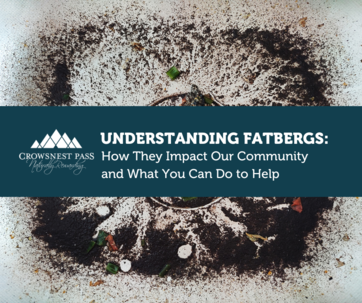Understanding Fatbergs: How They Impact Our Community and What You Can Do to Help

When we think about sewer blockages, we often imagine tree roots, debris, or even an occasional lost item. However, one of the biggest threats to municipal sewer systems is something you can’t see until it’s too late—fatbergs. These massive clogs form in underground pipes, causing costly damage and environmental risks. Here’s what you need to know about fatbergs, their impact on our infrastructure, and how you can help prevent them.
What Is a Fatberg?
A fatberg is a solid mass of grease, fat, oil, and non-biodegradable waste that accumulates in sewer systems. Over time, these materials stick together, harden, and form massive blockages, sometimes stretching for meters. Items that contribute to fatbergs include:
- Cooking oils, grease, and fats poured down drains
- Wet wipes (even those labeled as "flushable")
- Paper towels, tissues, and feminine hygiene products
- Dental floss and cotton swabs
- Food scraps and coffee grounds
Why Are Fatbergs a Problem?
When fatbergs form, they create severe blockages in municipal sewer lines, leading to:
- Sewer Backups and Flooding – Blocked pipes cause wastewater to back up into homes, businesses, and streets. This creates a public health hazard and expensive repairs for property owners.
- Costly Repairs for Taxpayers – Removing fatbergs is time-consuming and costly. Municipal crews must break them apart using high-pressure water jets, cutting tools, and even manual removal. These efforts cost cities thousands of dollars annually—expenses ultimately covered by taxpayers.
- Environmental Damage – When sewers overflow due to blockages, untreated wastewater can spill into rivers, lakes, and natural ecosystems, contaminating water sources and harming wildlife.
The 3 P’s: What Should Go Down the Toilet?
The best way to prevent fatbergs is to flush only the 3 P’s:
- Pee
- Poo
- Paper (toilet paper only)
Everything else—including wipes (even "flushable" ones), paper towels, feminine hygiene products, cotton swabs, and dental floss—should go in the trash. These materials do not break down properly in water and contribute to fatbergs, leading to costly sewer blockages and environmental risks.
What Can Residents Do to Help?
Preventing fatbergs starts at home. Here’s how you can protect our sewer system and prevent costly damage:
Dispose of Grease Properly – Instead of pouring oils and fats down the drain, let them cool and solidify, then scrape them into your compost or garbage.
Follow the 3 P’s Rule – Only flush pee, poo, and toilet paper. Everything else should go in the garbage.
Use a Sink Strainer – Catch food scraps and coffee grounds before they go down the drain. Compost or dispose of them in the trash instead.
Educate Others – Share this information with family, friends, and neighbors to help spread awareness and prevent future sewer blockages.
A Community Effort
Fatbergs are a growing problem, but with small daily actions, we can protect our municipal infrastructure, prevent costly repairs, and keep our community clean and safe. By following the 3 P’s rule and disposing of waste responsibly, we all play a role in ensuring a more efficient and sustainable sewer system.
If you have any questions about proper disposal methods or need more information, please contact the Operations Department at 403-562-8833.